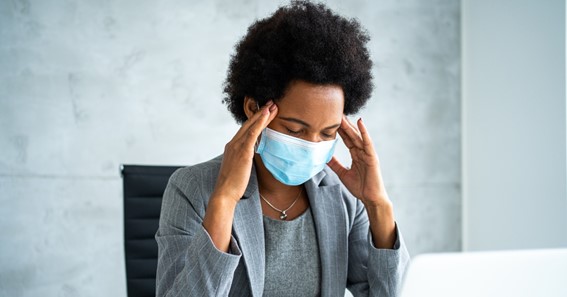Migraines are excruciating headaches usually felt on one side of the head. This debilitating headache is accompanied by pulsing sensations and symptoms such as vomiting, light and sound sensitivity, and nausea. Migraine episodes can persist for anywhere from a few hours to several days. This adverse medical condition impairs the ability to function normally. Medical research shows that these headaches affect approximately 9% of males and 19% of females at one point in their lifetimes. Both adults and children are vulnerable to migraines.
Stages of Migraines
According to Medicalnewstoday.com, the main stages of migraine are:
- The Prodrome Stage
A few hours before the onset of the headaches, 20 to 60% of the victims experience emotional issues like irritability and depression. Medics refer to this emotional upheaval as “prodrome.” One experiences frequent urination, malaise, dizziness, sensitivity to both sound and light, yawning, and excessive thirst.
- The Aura Stage
During the aura stage, the person sees bright flashing lights since the headaches affect the nervous system. These symptoms usually persist for 10 to 30 minutes at most. The signs of an aura are incoherent speech, tingling sensations, ringing in the ears, and temporary vision loss. The headaches also affect the person’s senses of touch, taste, and smell. You will also notice that your legs and arms become heavier than usual.
- The attack stage
The erstwhile dull headache morphs into debilitating pain. One feels dizziness, fever, stomach upsets, diarrhea, nausea, neck and upper back pain. You may also get nasal congestion and feel irritable. The throbbing pain may shift from one side of the head to another. This stage often lasts for 3 to 4 hours, but it can go on for days in extreme cases.
- The Postdrome stage
This stage is referred to as the migraine hangover or resolution stage in some texts. Its symptoms include dizziness, irritability, and general body weakness that becomes more pronounced. The affected individual feels unusually happy, bloated, and has strange food cravings. This “hangover” feeling often lasts for two or so days.
What causes migraines?
To date, doctors have been unable to trace the exact cause of this painful medical condition. Recent studies have shown that brain changes and genetic makeup trigger migraines. An overstimulation of the trigeminal nerve that innervates the facial and head muscles also triggers the condition. The prime causes are staying in brightly lit spaces, weather changes, fatigue, jet lag, low blood sugar, and lack of sleep.
Other migraine triggers include
- Diet
Consuming foods containing tyramine additives, caffeinated beverages, alcohol, citrus fruits, chocolates, nuts, Certain medications, Pills for birth control, hormone replacement therapy, and some sleeping medication.
Environmental triggers include bright lights, flashing and flickering, concentrated smells, noise pollution, and secondhand smoke.
- The Prevalence of Migraines
According to the American Migraine Foundation, some 38 million people in the U.S. suffer from this debilitating condition. Here’s how migraine’s risk factors get distributed in the population.
- Race
People of color, blacks, and indigenous populations are at high risk. That’s because these populations often lack access to healthcare. Studies show that only 47% of blacks get migraine diagnoses compared to 70% of whites. That fact notwithstanding, the prevalence of migraines is spread equally across the population.
- Gender
Generally, more females suffer from these painful headaches than males. Women are three times more susceptible to the condition than their male counterparts. Hormonal imbalances that occur during menstrual periods are to blame for the higher rate of migraines in women.
Click here – The Most Effective Method To Keep Your Family Protected
- Genetics
People from families with a long history of migraines are more vulnerable to developing migraines. Eight out of 10 people who suffer from this medical anomaly have family members with a history of this condition. The likelihood of parents passing on this trait to their children ranges between 50 and 75%.
- Underlying medical conditions
People who suffer from anxiety, sleep apnea, bipolar disorder, epilepsy, and depression are also at high risk of experiencing migraines.
Tips to get rid of chronic migraines
Even though there is no definitive cure or treatment for throbbing migraines, here are some tips to reduce the frequency and severity of the pain.
- Relax and calm down in a quiet and dark place.
Find a quiet and dark place to rest. This move helps to reduce the symptoms of light and sound sensitivity. Avoid bright lights in the house, staring at screens for too long, and noisy places to fight these excruciating headaches.
- Maintain ideal water levels
Stay hydrated. Water is an effective intervention to fight migraines. Keep replenished, especially during intense workouts and hot weather. The water helps to restore the brain’s electrolyte balance.
- Maintain proper growth hormone levels
Human growth hormone regenerates brain cells and improves cognitive functions like memory and learning. It helps slow down aging, lose weight, boost libido, and treat sleep apnea. The cost of HGH therapy, with injections, and other supplements and pills, depends on the country of origin, brand, and required dosage. Typically, it’s around $400 to $3000 per month. The treatment is legal only for people with proven low levels of the hormone..
- Using medications
Painkillers are effective for warding off migraines. The recommended pain medications include ibuprofen, naproxen, acetaminophen (Tylenol), and triptans, namely sumatriptan, gepants, ditans, or antiemetics. Don’t overuse these medications to avoid tolerance and overworking the liver.
- Red Light Therapy
Getting red light therapy is recognized as an effective and safe treatment for various health conditions. At the same time, it’s also known to boost cellular functioning and overall well-being naturally. Red light therapy helps modulate blood flow which prevents tension-type headaches and migraines from occurring. You can also use red light therapy beds at the comfort of your home.
- Get a relaxing massage
Massage of the head, face, and neck muscles is incredibly effective for reducing migraine pain. Apply gentle pressure on your temples for a few minutes to relieve the pain sensation. Dip your hands in solutions containing lavender oil, frankincense, and peppermint for fast relief.
- Stress management and meditation
Avoid stress to keep painful headaches at bay. Listen to soft music and have a positive mental state. Take up meditation to calm your mind, soul, and body. Yoga and other meditation practices are highly beneficial in the treatment of migraines.
The takeaway
Migraines have the potential to disrupt your daily life. If you suffer from repeated chronic headaches, reach out to a healthcare professional for diagnosis and treatment.
Click here – Commercial RO Water Plant: Know About Their Features





